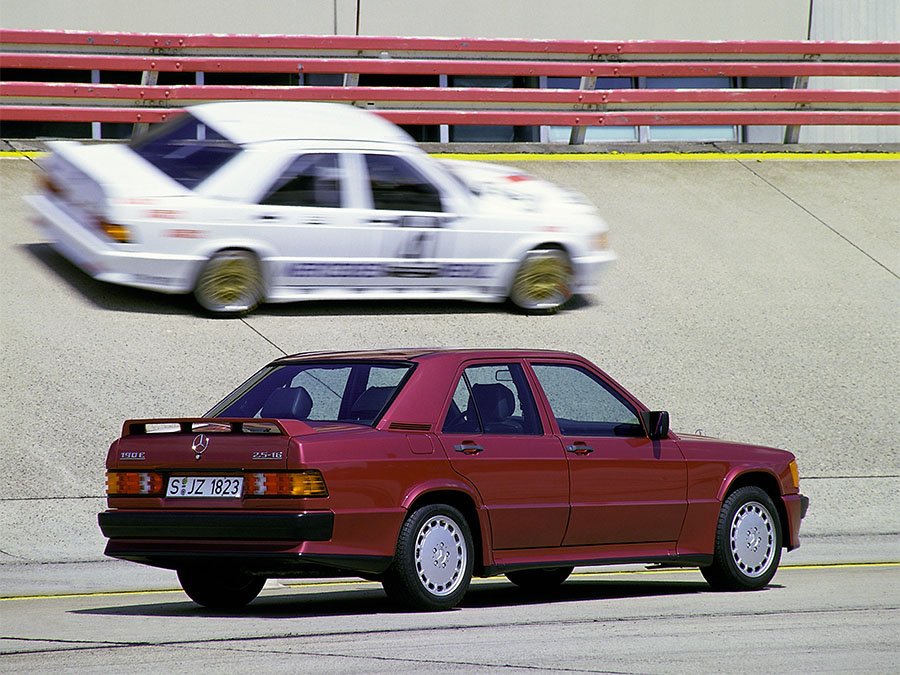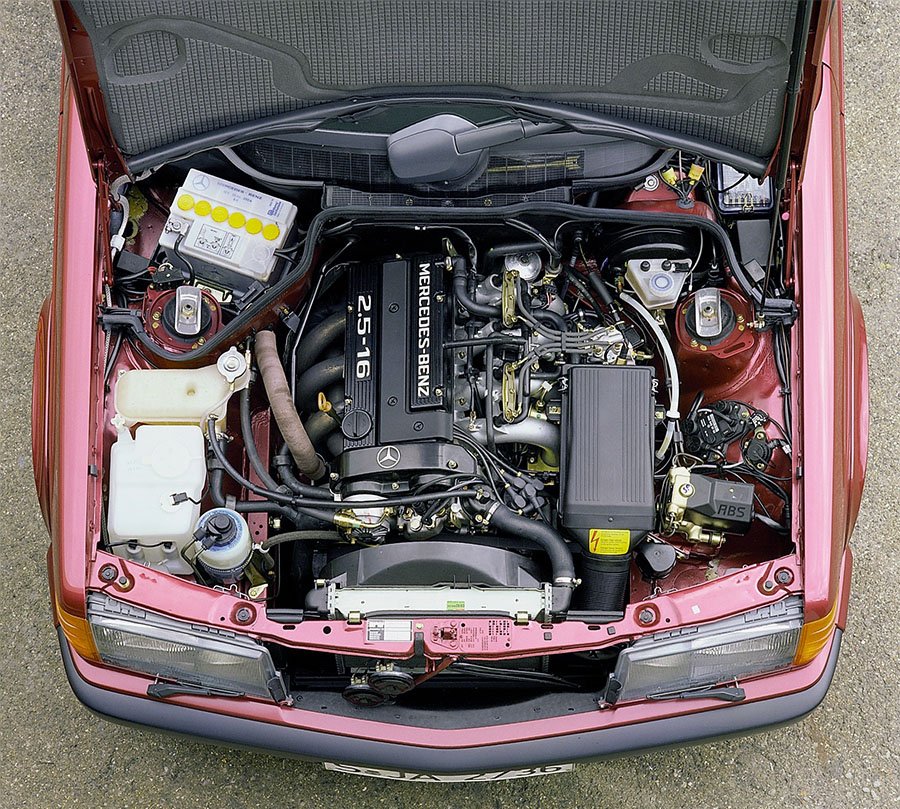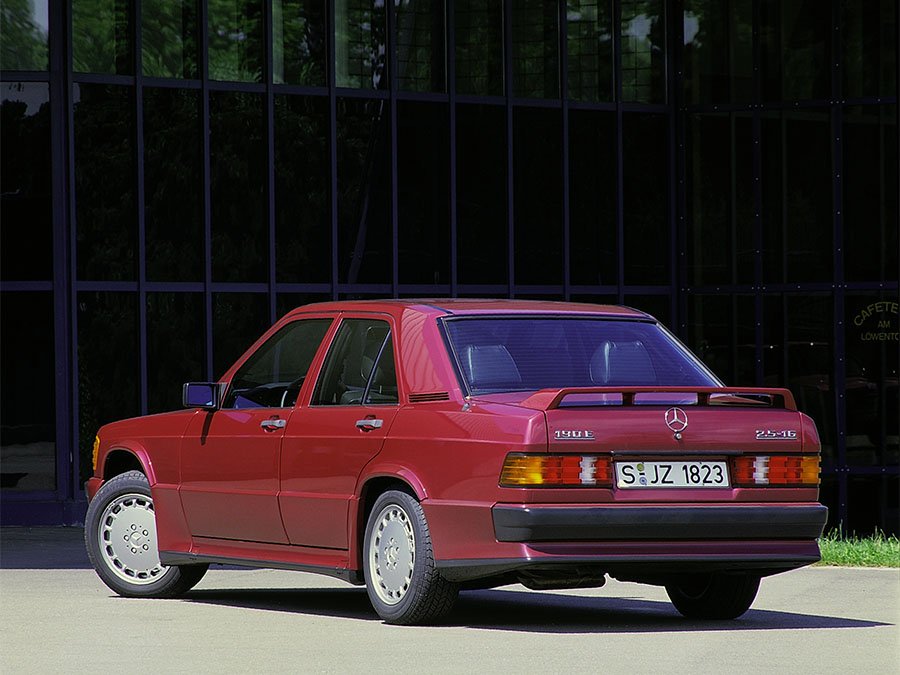Guide: Mercedes-Benz W201 190 E 2.5-16 - a Historical & Technical Appraisal
/BACKGROUND
Mercedes-Benz spent eight years and a vast sum of money to develop their vitally important compact-class W201 190. It turned out to be time and cash well spent as, by early 1988, a staggering one million of the things had rolled out of Mercedes’ Bremen and Sindelfingen plants.
At the Paris Motor Show in September 1988, Mercedes introduced a revamped 190 that incorporated a number of updates.
Deeper front and rear aprons were added to these 1989 model year variants along with slightly bigger bumpers. Behind the bumpers were new support elements and modified impact shocks that enabled a higher degree of energy absorption. Another safety feature was the new side protection bars concealed by W124-style sill cladding. A passenger-side exterior mirror was added to the list of standard equipment.
Inside, redesigned seats and an updated centre console were fitted. As a result of the new seats, knee and headroom in the back of the car was improved.
Mercedes introduced a new top-of-the-range 190 to their product line in Paris; the 190 E 2.5-16 was a replacement for the 2.3-16, production of which had ceased in June ‘88.
The 2.3-16 had been conceived as a Group A homologation special which meant at least 5000 had to be built within a twelve month timeframe. Mercedes ultimately hit this target with ease and, such was demand, the 2.3-16 remained as a permanent fixture in the model line up. By the time production ended, nearly 19,500 had been completed.
At the heart of the 2.3-16 was an engine that featured a special Cosworth head. Unlike regular 190 motors, this was equipped with dual overhead camshafts, four valves per cylinder and mechanical valve lifters. It endowed the car with spectacular performance and meant Mercedes had a high performance offering to rival other Group A specials like the BMW E30 M3, Lancia Delta HF Integrale and Ford Sierra Cosworth.
Apart from its slightly larger engine, the new 2.5-16 was to a broadly similar specification. It was created to allow the use of a bigger 2.5-litre engine in the Deutsche Tourenwagen Meisterschaft (DTM).
After years of leaving the 2.3-16’s motorsport career to privateers, Mercedes had decided to contest the 1988 DTM season in an official capacity. Although results were promising, it was felt a larger engine was needed to remain competitive. As a result, the 2.5-16 was created which spawned the further enhanced Evolution 1 upon which Mercedes’ DTM cars for 1989 were based..
Neither the 2.5-16 or the subsequent Evolutions were originally exported to the USA.
ENGINE / TRANSMISSION
The new Type M 102 E 25/2 engine replaced the outgoing 23/2 unit. Both incorporated a cast-iron block with a special light alloy cylinder head.
The major difference was an additional 199cc for the new motor. This was achieved by extending the stroke from 80.25mm to 87.2mm. The cylinder bores were kept at 95.5mm. Cubic capacity went from 2299cc to 2498cc.
Another significant difference was that the cylinder head was now produced in-house by Mercedes as opposed to at Cosworth Engineering in England. However, it retained the dual overhead camshafts, four valves per cylinder and mechanical valve lifters that differentiated these high performance motors from the rest of the W201 range.
Other changes in the transition to 2.5-16 trim included new inlet and exhaust manifolds. The throttle bodies, valve sizes and lift, timing chain and crankshaft were also different.
Like the 2.3 motor, the 2.5 incorporated wet-sump lubrication, a 9.7:1 compression ratio and Bosch KE-Jetronic fuel-injection.
Mid-way through the 2.3-16’s production run, Mercedes added RUF and KAT engines to the range. The RUF engine was an unleaded fuel version while the KAT unit was configured for unleaded fuel and also came with a catalytic converter.
The original ECE motor available from the 2.3-16’s launch had required leaded fuel and did not feature a cat. No such engine was offered for the 2.5-16.
Instead, the 2.5-16 was offered exclusively with a choice of RUF or KAT motors.
The RUF version pumped out 204bhp at 6750rpm (up from 177bhp at 5800rpm) and 177lb-ft at 5000rpm (up from 170lb-ft at 4750rpm).
The KAT version developed 194bhp at 6750rpm (up from 170bhp at 5800rpm) and 173lb-ft at 5000rpm (up from 162lb-ft at 4750rpm).
The 2.5-16 engines produced their power a little higher up the rev range than before and the delivery was a little lazier as a result of the longer stroke.
Transmission was once again through a Getrag five-speed manual dog-leg gearbox (complete with oil cooler), a single plate clutch and Mercedes’ electronically controlled Anti-Slip Differential (ASD).
ASD was a hydraulically locking differential that maximised traction. The electronic control allowed varied amounts of differential lock from the standard 15% right up to 100%. However, it was not a traction control system in that it did not prevent wheel spin. Activation of the ASD system was indicated by an illuminating amber triangle housed within the speedometer.
The only other mechanical difference on the 2.5-16 compared to its predecessor was a shorter differential (now 3.27:1 as opposed to 3.07:1).
CHASSIS
Each 2.5-16 was based on a standard 190 pressed steel bodyshell with a 2665mm wheelbase.
The front suspension layout comprised a MacPherson strut and separate spring arrangement. The back end used a five multi-link layout.
Anti-roll bars were fitted at either end along with anti-dive and anti-squat geometry.
Like the 2.3-16, Mercedes equipped the 2.5-16 with shorter and stiffer springs, firmer dampers, thicker anti-roll bars, harder bushings and a self-levelling rear axle. Ride height was 15mm lower than normal at the front and 12mm lower at the rear.
A quick steering rack was also installed.
7 x 15-inch Fuchs ‘Gullideckel’ alloy wheels were originally shod with Pirelli P6 tyres.
284mm ventilated discs were fitted at the front and 258mm solid discs were installed at the back.
Unlike regular 190s (which came with a 55-litre fuel cell), the 2.5-16 came with a 70-litre tank fitted over the rear axle.
BODYWORK
Aside from the aforementioned upgrades introduced for the 1989 model year, the 2.5-16 was cosmetically little changed. The body kit that differentiated it from the rest of the W201 range comprised a deep front spoiler and matching rear apron, side skirts, wheelarch extensions and a rear wing mounted on the boot lid.
By the time the 2.5-16 was introduced, the Bruno Sacco-designed 190 had been in production for six years. However, as a result of its restrained styling (the kind that typified Mercedes of this era), the lines still looked fresh.
Whereas the 2.3-16 was only offered with a choice of two exterior colours (Blue-Black and Smoke Silver) Mercedes added Almadin Red and Astral Silver for this latest iteration.
INTERIOR
The 2.5-16 was equipped with a few special pieces of interior equipment compared to the standard 190. Like the 2.3-16 it came with a small diameter leather steering wheel, a custom rev counter, a series of extra centre console-mounted gauges and more heavily bolstered sports seats front and back.
Behind the four-spoke steering wheel was a curved instrument binnacle that was neatly integrated with the rest of the dash. A large speedometer was flanked to the right by a slightly smaller rev counter inset with an analogue clock. To the left was a combined gauge for fuel level, water temperature, oil pressure and fuel economy.
Two additional read outs (an ammeter, digital stop watch and oil temperature gauge) were housed in the centre console underneath the ventilation controls and audio system.
All cars came with a Zebrano wooden insert for the transmission console.
Black leather was used to upholster the seat bolsters. The seat centres were trimmed in checked fabric to match the door panels. A mix of hard-wearing soft-touch black plastic and vinyl was used pretty much everywhere else.
As per most Mercedes of this era, the standard equipment level was quite basic.
OPTIONS
Optional extras included anti-lock brakes, leather upholstery, air-conditioning, electric windows (front only or front and rear), an electric sunroof, tinted glass, an outside temperature gauge, driver airbag, electric aerial, rear headrests, headlight wash/wipe, a higher capacity battery and rear speakers.
Buyers could also specify electric front seats, electric front seats with memory function or electric heated seats.
WEIGHT / PERFORMANCE
Compared to the 2.3-16, the 2.5-16 was 50kg heavier (1400kg as opposed to 1350kg).
Nevertheless, 0-62mph times for the RUF and KAT versions were about half a second quicker than before (7.2 and 7.3 seconds respectively).
At 148mph and 145mph, top speed of both variants was 6mph faster.
AMG POWER PACK
When the 2.5-16 Evolution 1 was launched at the Geneva Motor Show in March 1989, it was offered with an AMG Power Pack that was also made available on the standard 2.5-16.
At a nigh on 30% premium over the list price, customers could have an engine enhanced to produce 225bhp at 7200rpm and 177lb-ft at 5500rpm. A tuned exhaust was also included.
PRODUCTION CHANGES
For the 1990 model year, Astral Silver was dropped in favour of a new shade called Brilliant Silver.
END OF PRODUCTION
Mercedes produced the 2.5-16 from July 1988 to June 1993.
5743 were built compared to nearly 19,500 examples of the 2.3-16.
Although the number of cars built to right-hand drive specification was greater than for the 2.3-16 (when 600 were constructed), at present we do not have precise figures for these cars.
Text copyright: Supercar Nostalgia
Photo copyright: Mercedes-Benz - https://www.mercedes-benz.com



































